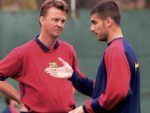One of the most notable tactical trends of the 21st Century is the death of the 3-man defense. In the 1980’s and 1990’s the 3-man defense grew into prominence in World football as a way to counter the most influential formation in modern football, the orthodox 4-4-2. The orthodox 4-4-2 is a system based around partnerships: pair of Center Forwards, Fullbacks and Wide Midfielders, pair of Central Midfielders, and pair of Center Backs. It allows a team to naturally occupy the most space on a field. Finally, the 4-4-2 is a very flexible formation: it can be very attacking with the two Center Forwards, or it can be very defensive with the midfield and defensive lines acting as two defensive lines of four. The 4-4-2 gets it width from its Wide Midfielders who play with their strong foot wide and look to attack the opposing byline and swing crosses into the box for the two Forwards, while the Fullbacks stay deeper and provide defensive cover. The pair of Central Midfielders are charged with pushing forward in attack to help support the Center Forwards and dropping deep in defense to provide protection for the Centerbacks.
The Back-3 defense was created as a way to counter teams built around an orthodox 4-4-2. Using three Center Backs created four distinct advantages vs. an orthodox 4-4-2. First, with an extra Center Back, teams who played with a Back-3 now had extra defender to provide cover against the opposition’s strike partnership. Second, with the extra Center Back, teams could now afford to play an extra Central Midfielder, giving the teams who played with a Back-3 a one-man advantage in the center midfield. A three-man central midfield exploits the space between the orthodox 4-4-2 lines with either a free Holding Midfielder (in a 3-5-2) in between the orthodox 4-4-2’s attacking and midfield lines), or a free Attacking Midfielder (in a 3-4-1-2) between the orthodox 4-4-2’s midfield and defensive lines). Third, with the extra Center Back, teams are able to play Wingbacks, giving them more freedom and support to attack. Finally, if a team chooses to play with two Center Forwards in either a 3-5-2 or a 3-4-1-2 formation, they are able to exploit the lack of defensive cover that their opposition has in their defense creating one on one defending for each Center Back against each Center Forward. Formations featuring a Back-3 were able to exploit the specific weaknesses created by the vulnerabilities of the orthodox 4-4-2.
Football primarily is a game of space. The team that wins is the team that is able to give its skill players the most space to create and at the same time deny that space from its opposition. As playing roles evolve and develop, usually the players who are allowed more natural space become more creative and progressive. This led to the development of the Attacking Fullback position. As the 4-4-2 came to dominate European football, there were many occasions where two teams who played an orthodox 4-4-2 formation played against each other. When these teams met, both of their central midfields were marked out by the opposition’s central midfield and the opposition’s Centerbacks marked both teams’ Center Forwards. This only free players for both teams were their Fullbacks.
As teams looked for more effective ways to attack the ball was pushed out wide to fullbacks, it was the fullback who was given more attacking responsibility. Attacking Fullbacks became essential to winning in European Football in the first decade of the 21st Century. As teams became reliant on Attacking Fullbacks, the more important these Fullbacks became to the tactics and success of teams. To accommodate the advanced runs of Attacking Fullbacks, managers started playing their Wingers in an inverted fashion, with their strong foot on the inside of the field instead of on the touchline. This changed the movement of the Wide Midfielders/Wingers who instead of hugging the touchline, would cut centrally into midfield. This created space for the attacking Fullbacks, not only by the movement of the Wide Midfielder/Winger, but by also pulling the opposition Fullback, who was marking the Winger and drifting centrally to cover him, thus creating space for the attacking runs of the Fullback. Wingers also had a useful defensive function. With more attacking Fullbacks, teams relied more on them to create goal scoring opportunities. By playing wingers, teams had a natural defender for attacking Fullbacks and with an extra central midfielder, there was more defensive cover to allow teams to push their Wingers into more advanced positions.
The genesis of this switch started in Spain in the 1990’s, but gained national prominence with a Deportivo de La Coruña side that played a 4-2-3-1 formation and won their first ever La Liga title. Even though they had challenged regularly in the 1990s, they won the 1999-2000 La Liga title and made deep Champions League runs in 2000-2001 and 2001-2002 reaching the Quarterfinals. They also had a 2003-2004 Champions League Semifinal run, where they were one goal away from reaching the Champions League Final.
At the same time another financially smaller Spanish club reached new heights because of a switch to a 4-2-3-1 formation. Rafa Benítez was hired as the manager of Valencia. When Benítez arrived at Valencia, his first major decision was to switch the formation to a 4-2-3-1 with a clear Center Forward, Mista, and an attacking midfielder named Pablo Aimar, who played in the attacking hole under Mista. Under Benítez, in his first season, Valencia won the La Liga title for the first time in 31 years beating out a 2nd place Deportivo de La Coruña. In the 2001-2002 season, Valencia was able to reach the quarterfinals of the Champions League, and in 2003-2004 Valencia not only won the La Liga title again, but they also won the 2003-2004 EUFA Cup. As the smaller clubs started winning with this new tactical system, the bigger clubs in Spain adopted the three-man attack.
One of the most famous matches in the history of the Modern Champions League is Real Madrid’s 3-2 away victory over Manchester United. In the match, Real Madrid played a modern 4-2-3-1, while Manchester United played an orthodox 4-4-2. Throughout the match the two man central midfield of Manchester United, Paul Scholes and Roy Keane, was not able to deal with the three Central Midfielders of Real Madrid. Real Madrid’s Wingers, also cut in centrally to overload Manchester United in the middle of the field, creating room for Real Madrid’s Attacking Fullbacks to overlap. In the 20’ minute, the first goal for Real Madrid highlighted the many problems that the orthodox 4-4-2 had against three man attacking lines and 3-man midfields. Real Madrid’s 1st and 3rd goals highlighted these flaws. For Real Madrid’s first goal, Denis Irwin, Manchester United’s Leftback, crossed the ball attempting to create a goal scoring chance for Manchester United’s strike partnership. Paul Scholes made a late run into the box to support their front two. He missed the ball and left Roy Keane isolated as Manchester United’s only Central Midfielder and Manchester United’s defense was exposed. Ryan Giggs had to come from his left wing position in an attempt to mark a Real Madrid Central Midfielder. This left Real Madrid’s Rightback, Micheal Solgado, uncovered and free to make an attacking run. Real Madrid’s Right Winger, Steve McManaman, drifted centrally creating space for Solgado to run into unmarked and he crossed the ball. Roy Keane, trying to defend the cross, kicked the ball into his own goal. For Real Madrid’s third goal, Manchester United lost the run of Real Madrid’s Central Attacking Midfielder, Raul, who was able to make an uncovered run and tap the ball into the goal giving Real Madrid a 0-3 lead.
Three man-attacking lines began to gain footing in the Premier League when José Mourinho was hired to manage Chelsea in 2004. Chelsea, under Mourinho, was the first team to primarily employ a three man attacking line and midfield as their primary formation. The most important player for Chelsea was Claude Makélélé, a Defensive Midfielder, who positioned himself in the hole between Chelsea’s Central Midfielders and Central Defenders. He didn’t cover a lot of territory, wasn’t an expansive passer, and rarely scored; but he was able to provide defensive cover. He allowed Chelsea’s Central Midfielders the opportunity to attack more, because they always knew that Chelsea’s Centerbacks were protected. Makélélé was the foundation of the midfield that gave Chelsea the advantage in their 2004-2005 and 2005-2006 Premier League Championship titles. He is the namesake for the Makélélé role, a Defensive Midfielder who sits in the defensive hole providing cover for his team’s Centerbacks allowing the teams more creative players, i.e., the Central Midfielders, Wingers, and Fullbacks, to have the freedom to create and attack knowing there is defensive cover for their Centerbacks. The adoption of the Makélélé role allowed more club teams to switch from the 4-4-2 formation to the 4-2-3-1/4-3-3 formation. Formations based around a three-man attack quickly spread across Europe: from Spain, to England, France, The Netherlands and Germany. As this happened the value of the three-man defense declined. The only country where a three-man defense stayed fashionable was Italy; where culturally teams don’t t develop Wingers still predominantly deployed two-man attacking lines.
The growth of three-man attacking line led to the death of the Back-3 defenses, as many of its strengths were either negated or became weaknesses. The advantage of playing a Back-3 was gone because three Center Backs defended against a Center Forward and two Inverted Wingers. The three-man defense is most vulnerable defending against counter attacks with a high defensive line, as fast Wingers can get in behind slower Center Backs and there is no extra defender to provide cover. When a three-man defense team is forced deep, all five of their defenders are forced deep. The three Center Backs and two Wing Backs are forced back by the opposing attacking three. This creates a 5 vs. 3 matchup, which is fine in defense; but limits the ability for the defending team to transition to attack. By removing a Center Forward and adding a Central Midfielder, the team who plays with a back three loses the advantage in midfield against a team that plays with an attacking three. In attack, the team that has a defensive back three, has a spare defender making it harder for them to play through defensively organized opposition. With more teams switching to three man fronted attacks such as the 4-3-3 and 4-2-3-1, and leaving two man attacks, such as the 4-4-2, the prevalence of teams using Back-3s fell and more teams returned to four man defenses that were more suited to defending Back-3s.
Pep Guardiola managed Barcelona from 2008-2012. He built the most dominate team of the decade based around a 4-3-3 formation and a style of play based around ball possession. Barcelona was based around the central midfield players that were all built and developed at Barcelona’s famed La Masia youth facility. Xavi Hernandez is the axis of the midfield, calmly dictating their attack and switching play from side to side. Andreas Iniesta is a tricky and intelligent Attacking Midfielder who was skilled at creating scoring opportunities in tight areas. Lionel Messi, a “False 9” dropped deep into central midfield to provide an extra passing option in tight areas.
With this collection of world class Central Midfielders, Barcelona dominated possession to the point where the only option other teams had to compete with Barcelona was to pack 9-10 players deep and narrow in their own box in an attempt to deny Barcelona’s small and technical players space in which to create scoring chances. To counter their opposition’s narrow play, Barcelona dropped their Holding Midfielder, Sergio Busquets, deep and between their Center Backs. This allowed Barcelona’s Centerbacks the freedom to spread wide to create a back three and turn their Fullbacks into Wingbacks to expand the playing area and force the defending opposition to defend more area. This also gave both of their Wingers the ability to play centrally and help link play. The positional movement of Sergio Busquets was adopted by many of the top clubs and international teams. This worked for them because they had to consistently defeat teams who chose not to challenge for possession or territory, but rather preferred to sit deep in their own half in an attempt to keep the ball in front of them and to deny their more technical opposition scoring opportunities.
Beginning in the 2008-2009 season, Barcelona dominated Europe. Barcelona won Two Champions Leagues (2008-2009 and 2010-2011), Four La Liga titles (2008-2009, 2009-2010, 2010-2011, and 2012-2013) and Two Copa Del Ray Championships (2008-2009 and 2011-2012). Barcelona players were also the backbone of a Spanish National Team that won Two European Football Championships (2008 and 2012) and the 2010 World Cup. This possession-based attack built, partially around the attacking movements of Sergio Busquets, led to possession-based football becoming the defining tactic of many teams in Europe. Also, the Busquets role, with a Holding Midfielder dropping deep in attack became a required skillset for the better high end holding midfielder in Europe.
At the beginning of the 2008 Season, Borussia Dortmund hired Jurgen Klopp to manage their team in an attempt to regain success after a tumultuous time that included the club almost going bankrupt and sub-standard results. He brought with him a new style of play that built around organization, intelligence and physical exertion. It was perfect for a club that, because of their financial struggles, was relying on young inexperienced players or older players who lacked the high-end technical ability that would have driven up their price.
The foundation of Klopp’s system was a form of pressing known as gegenpressing. Gegenpressing is a direct descendent of the tactical system created by Arrigo Sacchi at AC Milan, which won Two European Cups in Four years. This system is built around an aggressive, organized and coordinated press, which works in tandem with narrow positioning from Dortmund’s wide players, a high defense line and an aggressive offside trap in an attempt to compress the area in which the attacking team can retain possession. Klopp used a 4-4-2 defensive press and negated the biggest flaw of the formation, the space between the midfield and defensive lines. Borussia Dortmund primarily played a 4-2-3-1, with a clear Forward and Attacking Midfielder. In the defensive pressing phase, however, the Center Forward dropped deep to partner the Attacking Midfielder. Together they marked the opposition’s deepest Central Midfielder allowing their double pivot to sit deeper and focus on the remaining central midfielders and providing cover to their Centerbacks. This formation denied their opposition the ability to play through Dortmund centrally and forced the opposition to play the ball wide or over the top of Dortmund’s defensive line. The second piece of this tactic was a pair of Attacking Fullbacks, whose job it was to provide width for Dortmund attacks, and inverted Wingers, who looked to run centrally and provide central support for their double pivot. This allows the double pivot to never become overwhelmed in midfield.
In the Season before Klopp’s arrival, Borussia Dortmund finished 13th in the Bundesliga. After his first season as manager of Borussia Dortmund, the team finished in 6th place in the Bundesliga; after his second season, Borussia Dortmund finished in 5th place. The 2010-2011 season was a breakout season for Borussia Dortmund; Borussia Dortmund was able to win the Bundesliga for the first time since the 2001-2002 season. The next season was even better as Borussia Dortmund was able to win the domestic German double, including setting the Bundesliga points record, ending the season with 81 points. They also demolished Bayern Munich 5-2 in the DFL Pokal Final in one of the greatest victories in club history.
All of Europe was aware of Borussia Dortmund and their innovative style of play as well. Many teams around Europe attempted to model their style of play after Borussia Dortmund. This style of play was seen as a proactive way to play without relying on possession. Many mid to small table clubs around Europe imitated Borussia Dortmund as they now had a strategy to build a competitive team and style of play with limited funds. Even bigger clubs incorporated this tactic when they went into matches against other clubs where they knew they ball retention would not be the best strategy for winning the match.
Ironically, the club that exemplified this most was Bayern Munich. After the embarrassment of the DFB Pokal final and losing back-to-back Bundesliga titles, Bayern Munich decided to flex their financial muscle. They signed three new starters: Dante their best Centerback; Javi Martinez, a physical and powerful, but still technical, holding midfielder; and Mario Mandzukic, a more energetic, physical and athletic starting Center Forward. Bayern Munich’s most impressive match of their season was their 7-0 victory in the Champions League Semifinal against Barcelona. Even though Bayern Munich had the second highest average ball retention of all the European teams, against Barcelona their tactical strategy was based around a physical and organized 4-4-2 press. This strategy was able to overpower Barcelona’s smaller and more technical Midfielders and force them to play deeper, breaking up Barcelona’s buildup. This strategy was very similar to the pressing strategy that Jurgen Klopp uses at Borussia Dortmund. In the Champions League Final, Bayern Munich beat Borussia Dortmund, who had advanced to the final by beating Real Madrid in the other Champions League semifinal. This further cemented Jurgen Klopp’s pressing style in Europe and demolished the most dominant club team of the 21st Century.
During the 2013-2014 La Liga season, Atlético Madrid was able to win the 2013-2014 La Liga title becoming the first team in La Liga to beat the financial duopoly of Barcelona and Real Madrid. Like Borussia Dortmund, their style of play was built around a 4-4-2, which was their primary formation, utilizing compactness, discipline and an aggressive press. Throughout the season, for a championship winning side, Atlético Madrid had remarkably low possession and pass completion statistics. Atlético Madrid was 9th in the league in possession at 48.9% and 11th in pass completion at 77.3%. Also, Atlético Madrid was able to reach the Champions League final by relying on their pressing style of play. Even though they lost the match to Real Madrid in extra time, Atlético Madrid was able to control the match, force Real Madrid to change their tactics multiple times, and a late goal from a corner kick was the only thing that saved Real Madrid from losing the Champions League final. Again, a team, which did not have the financial power of their opponent, was able to install a 4-4-2 press and beat that opponent in direct competition.
Pep Guardiola was hired as the manager for Bayern Munich in an attempt to bring the style that he created at Barcelona. His goal was to replicate the success that Bayern Munich had created the previous season by winning the Treble: the Bundesliga title, the DFP Pokal title, and the Champions League title. Bayern Munich was comfortably able to dominate the Bundesliga with their squad depth, however as they progressed deep into the second half of their season, their team began to fall apart. The first cracks began to show on April 12, 2014 in their home match with 2nd place Borussia Dortmund. Borussia Dortmund came out in a 4-4-2 formation sliding their most dangerous attacker, Marco Reus, from the Wing and playing him as a second Center Forward. Even though Borussia Dortmund was missing 6 of their starters and had only 29% of possession throughout the match, Borussia Dortmund’s organized and aggressive press dominated Bayern Munich and they won the match 3-0.
Eleven days later, Bayern Munich played against Real Madrid in the Semifinal of the Champions League. Real Madrid was struggling with injuries to their starting Central Midfielder Sami Khedira and Wing/Forward Christiano Ronaldo. To compensate for these injuries, Real Madrid switched to a 4-4-2 formation with Ronaldo switching from the wing to the second Center Forward position, just as Reus had switched for Borussia Dortmund to limit the amount of running he had to do in the match. Real Madrid relied on an organized, compact and disciplined press and transition attack. Real Madrid only had 28% of possession throughout the match and only 41.2% of territory in the first leg, but they used their press to isolate Bayern Munich’s midfield from their front three and limited Bayern Munich to only four shots on target. Real Madrid had five shots on target and the only goal of the match. In the second leg, Real Madrid knew that Bayern Munich had to score and open up their formation to attack. They continued with their 4-4-2 press and Real Madrid was able to score 4 goals in Germany giving them an astonishing 5-0 victory over the reigning Champions League champions and the most dominant team in Europe over the past two seasons.
Once again, as with Borussia Dortmund in the Bundesliga in 2010-2011, 2011-2012, and in the 2012-2013 Champions League; Bayern Munich over Barcelona in the 2012-2013 Champions League Semifinals; and Atlético Madrid in 2013-2014 La Liga season and in their run to the Champions League Final, a team built around an aggressive, disciplined, and organized 4-4-2 defensive press was able to control and dictate matches against more technically skilled and possession oriented teams. Now Pep Guardiola faced a dilemma. He was in a position where he had to resurrect what had become a disappointing season after Bayern Munich’s embarrassing loss to Real Madrid. He was also facing a side in Borussia Dortmund who would play the same style of play that had embarrassed his side the last three times they had played against it. He solved the problem of his opponent playing a 3-4-2-1 formation against Borussia Dortmund’s 4-4-2 and press by playing a permanent Back-3.
The most important player for Bayern Munich was Javi Martinez, who played as a Libero, a position that has not been fashionable since the Back-3 had fallen out of style. In Bayern Munich’s defensive phase and Borussia Dortmund’s transition phase, Martinez always stayed deep behind Bayern Munich’s other Centerbacks, Dante and Jerome Boateng. His presence was essential as the extra Centerback because it created a 3 vs. 2 defensive advantage and allowed for a spare defender to provide defensive cover against Borussia Dortmund’s attacks. With the extra defensive solidity throughout 120 minutes, Borussia Dortmund was limited to three shots on target throughout the entire match. Bayern Munich’s use of a back three allowed them to control and defeat the specific tactic that had exposed them and had begun to dominate European Football.
-Nicholas Peters










One Response
Very interesting article, although is a bit unclear how the 4-4-2 formation, that at the beginning is stated to suffer the 4-2-3-1/4-3-3 formation was able to dominate so vigorously at the beginning of the 2010s against the same type of formation that was used to beat it. Is it only thanks to pressing and counter-play? How did they overcome the tactical weakness against the three man midfield?